MacBook Air vs Pro: Differences between MacBook Air and Pro | Macworld
Apple currently sells two laptop lines: the MacBook Pro (which comes in 13-inch M2, 14-inch M2 Pro/Max and 16-inch M2 Pro/Max models) and the MacBook Air (which is available in 13.3-inch M1 or 13.6-inch M2 models). That is a lot of Mac laptops with very different specs.
Within that line up are a collection of similarly speced 13-inch Mac laptops that are designed for home, student, and office use. These include the 13.6-inch MacBook Air and the 13-inch MacBook Pro, which both feature the M2 chip and went on sale in July 2022, and an older M1-equipped 13.3-inch MacBook Air model launched in 2020. There are also rumors suggesting that Apple might launch a 15-inch MacBook Air. The 14- and 16-inch MacBook Pro models are better suited to pro users.
It’s these 13-inch Mac laptops we are most interested in here. In this article we compare the 13-inch MacBook Pro with the MacBook Air to help you decide which one to buy.
If you are wondering whether your needs might extend a little further on the pro side, you may also be interested to read: Which MacBook Pro: 13, 14, 16-inch compared. Elsewhere we look at the MacBook Air M1 vs M2 and the two versions of the M2 MacBook Air compared. For advice about the best MacBook we also have a buying guide, see: Best MacBook 2023: Which Mac laptop is best?
Mục Lục
Apple MacBook Air M2 (2022)


Read our review
Apple 13-inch MacBook Pro (M2, 2022)
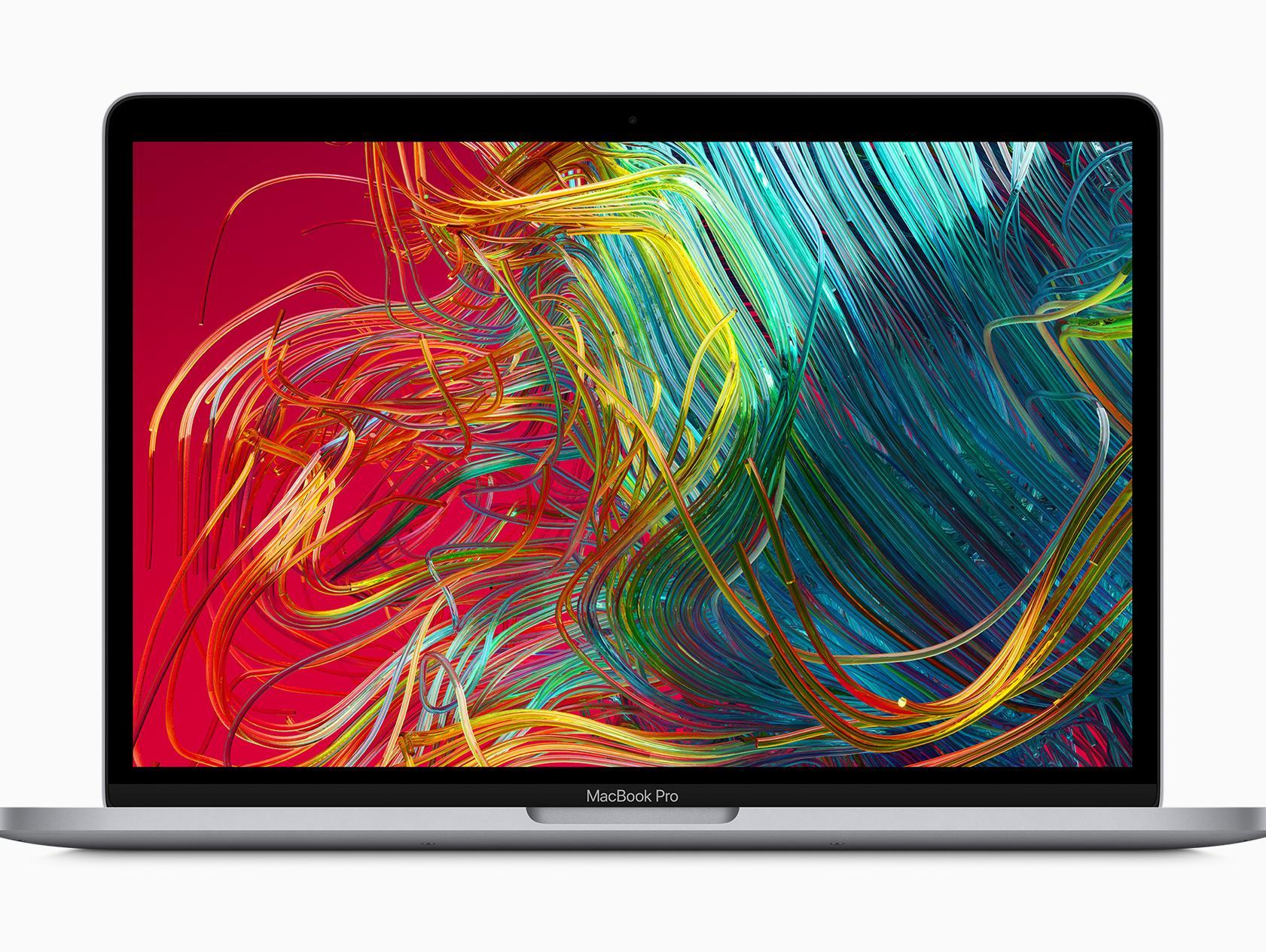
Read our review
MacBook Air vs MacBook Pro: Design
In some ways the design of the 2022 MacBook Air and MacBook Pro are more alike than ever. The 2022 MacBook Air lost the tapered design that made it instantly identifiable as the Air (and is still available if you buy the M1 version of the MacBook Air). Now the MacBook Air looks like a thinner version of the MacBook Pro. However, there’s a lot to set these two Macs apart.
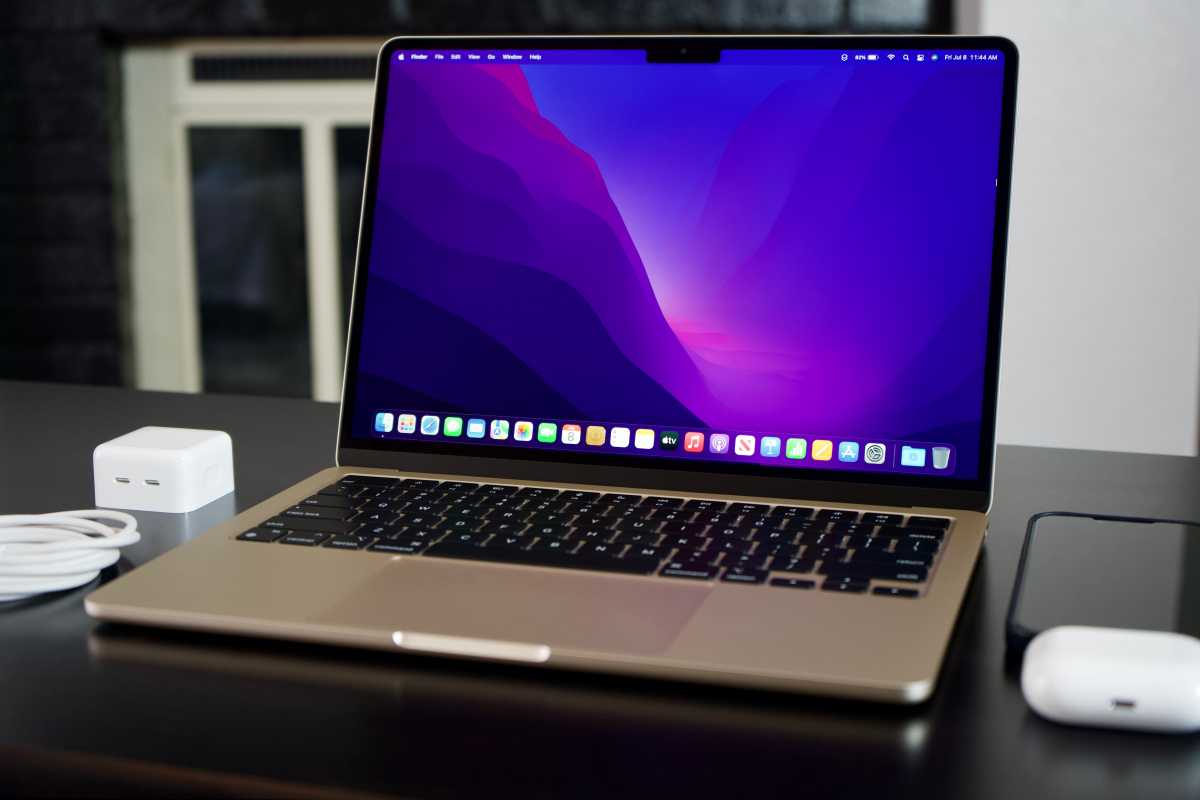 The M2 MacBook Air no longer has the tapered design that the Air was recognisable for.
The M2 MacBook Air no longer has the tapered design that the Air was recognisable for.
IDG
Thanks to an extensive redesign in 2022, the MacBook Air has many features that the 13-inch MacBook Pro lacks. Most significant is the fact that the 2022 MacBook Air has a larger 13.6-inch screen with slimmer bezels, while the 13-inch MacBook Pro has an older 13.3-inch display (the same as the M1 MacBook Air). There is one potential disadvantage to this larger screen – it incorporates a notch, as seen on the 14-inch and 16-inch MacBook Pro, iPhones, and some iPads. Some people do not like the notch, we feel that it’s forgivable because it allows Apple to increase the size of the screen since it really just sits in the menu.
Another notable difference is that the 13in MacBook Pro is the only Mac laptop that features Apple’s Touch Bar strip. Apple removed the Touch Bar from the 14-inch and 16-inch MacBook Pro models with the 2021 models, so if you want the Touch Bar the 13-inch MacBook Pro is the only Mac laptop to offer it. All three MacBooks have the same Magic Keyboard with scissor-switch keys. All of the models also have a Touch ID sensor and Force Touch trackpad.
 The M2 MacBook Pro has the Touch Bar, the M2 MacBook Air does not.
The M2 MacBook Pro has the Touch Bar, the M2 MacBook Air does not.
As you would expect from the name, the MacBook Air is lighter than the MacBook Pro, but only slightly. When it launched in 2008, the MacBook Air was the lightest laptop available, but over the years the weight of the MacBook Pro has also declined, so the difference is a lot less now:
- M2 MacBook Air: 2.7 pounds (1.24kg)
- M2 MacBook Pro: 3 pounds (1.4kg)
- M1 MacBook Air: 2.8 pounds (1.29kg)
Following its redesign the 2022 MacBook Air is actually very slightly larger than the 13-inch MacBook Pro. That change is what allows Apple to accommodate a larger display. The measurements of the M1 MacBook Air are the same as the 13in MacBook Pro.
- M2 MacBook Air: 30.41cm x 21.5cm x 1.13cm
- M2 MacBook Pro: 30.41cm x 21.24cm x 1.56cm
- M1 MacBook Air: 30.41cm x 21.24cm x 1.61cm-0.41cm
Another difference between these MacBooks is the color choices. The 2022 MacBook Air comes in some brand new colors: Midnight (dark blue), Starlight (gold), Space Gray and Silver.
The MacBook Pro offers only the silver and space grey options. The M1 MacBook Air comes in silver, space gray and gold. The new Starlight shade is paler gold, while Midnight is close to black with a dark blue hue.
 There are four different color options for the 2022 MacBook Air.
There are four different color options for the 2022 MacBook Air.
Apple
MacBook Air vs MacBook Pro: Display
The 2022 MacBook Air has a new display that is larger and brighter than the M2 MacBook Pro, and a leap from the display on the previous generation MacBook Air.
The M2 MacBook Air offers a 13.6-inch Liquid Retina display, rather than a plain old Retina display. This essentially means the newer display has a better contrast ratio and can support more colors (a billion versus millions). However, neither is as good as the Liquid Retina XDR displays in the 14-inch and 16-inch MacBook Pro models. Those more expensive MacBook Pro options bring up to 1,000 nits of brightness (versus 500 on the M2 MacBook Air and 400 on the M1 MacBook Air), deeper blacks and more vivid colors as well as ProMotion.
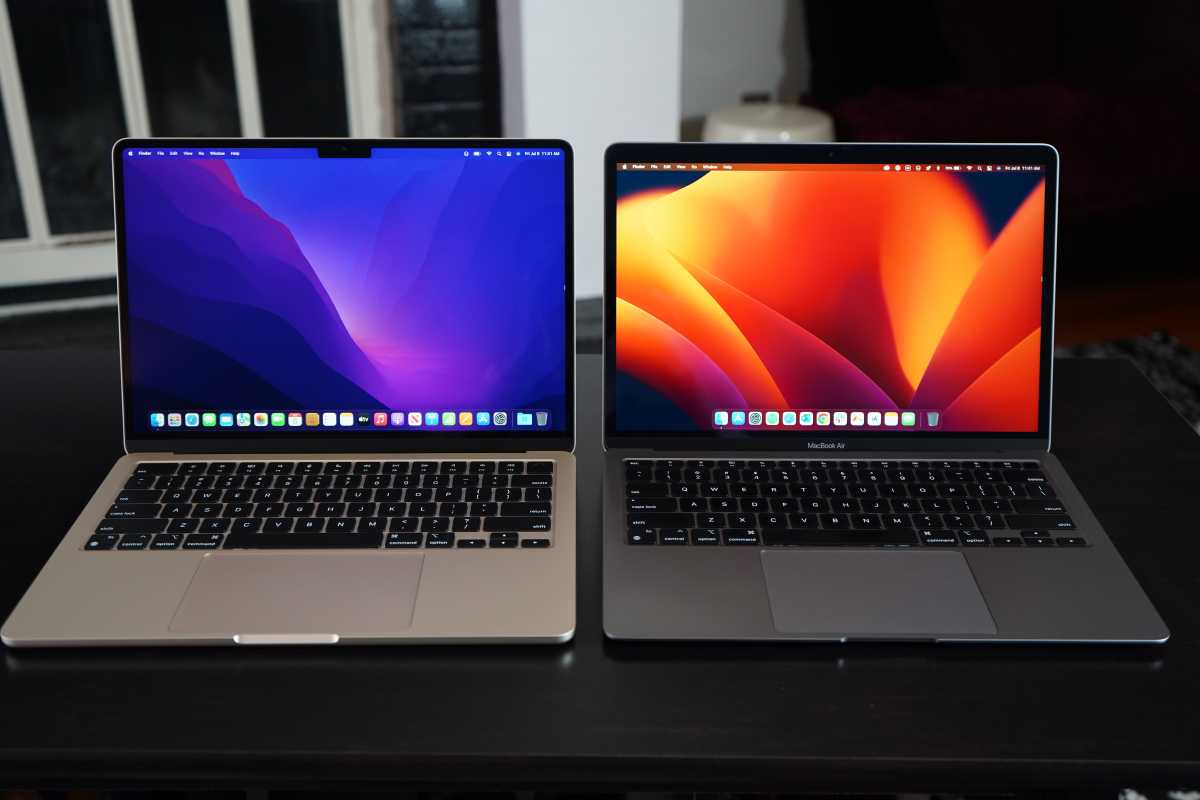 The display is bigger on the M2 compared to the M1 MacBook Air. Plus there’s a notch.
The display is bigger on the M2 compared to the M1 MacBook Air. Plus there’s a notch.
IDG
Due in part to the fact that the 2022 MacBook Air screen is slightly taller, with a diagonal measurement of 13.6 inches rather than 13.3 inches, the MacBook Air display now offers slightly more pixels:
- M2 MacBook Pro: 2,560 x 1,600 pixels
- M2 MacBook Air: 2,560 x 1,664 pixels
- M1 MacBook Air: 2,560 x 1,600 pixels
If the rumors are true a 15-inch MacBook Air could be coming.
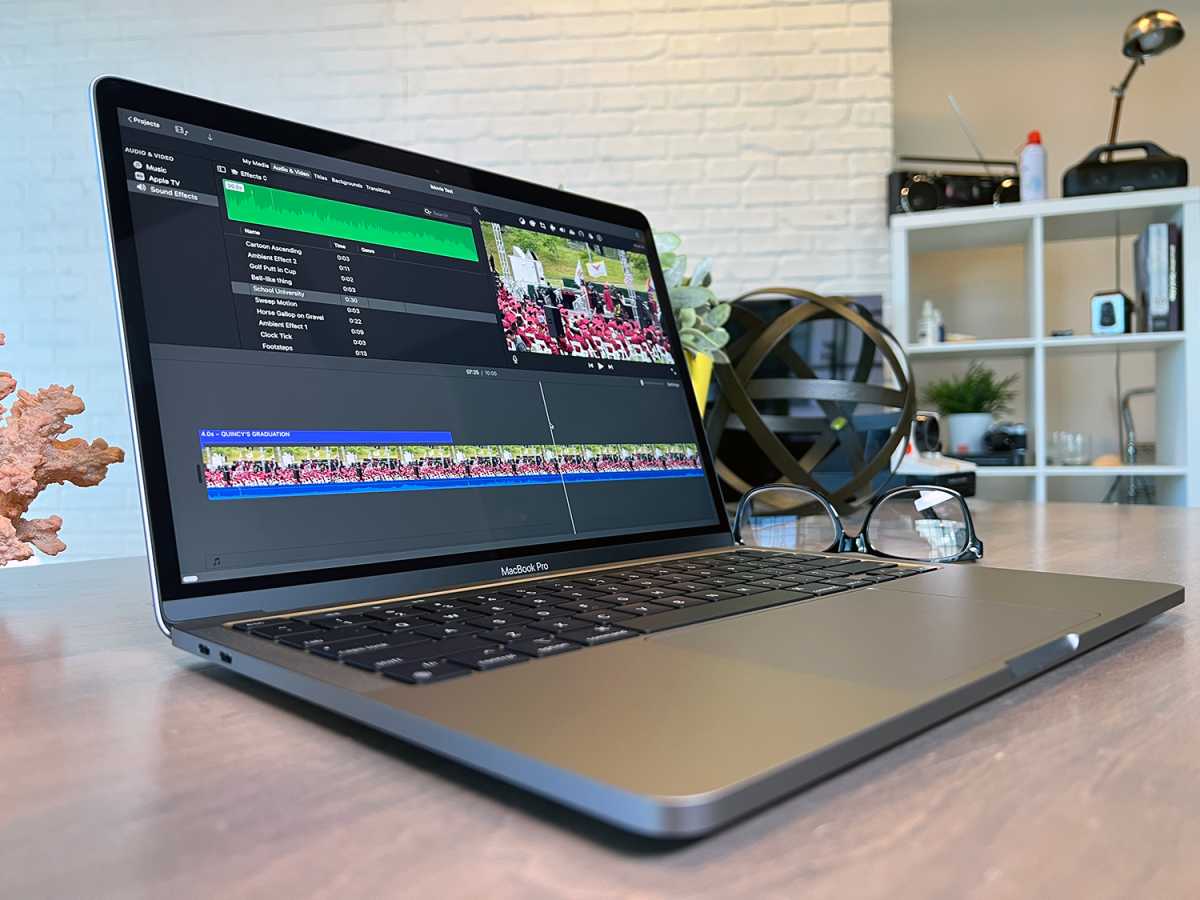 The M2 MacBook Pro hasn’t changed much compared to the M2 MacBook Pro
The M2 MacBook Pro hasn’t changed much compared to the M2 MacBook Pro
Foundry
MacBook Air vs MacBook Pro: Specs
All Apple’s laptops run on its own system on chip. First the M1 arrived in November 2020, then the M1 Pro and M1 Max in October 2021, and the M2 arrived on the 2022 MacBook Air and 13in MacBook Pro in July 2022. Since then the more powerful M2 Pro and M2 Max have arrived on the larger MacBook Pro models. We have more about the M2-series here: Apple’s M2 chip: Everything you need to know.
Here’s how the 13-inch MacBook models break down, if you are interested to find out how the 13-inch MacBook Pro compared to the 14-inch and 16-inch MacBooks read our separate comparison.
MacBook Air, M1 (2020, $999/£999)
8-core CPU with 4 performance cores and 4 efficiency cores
7-core GPU
16-core Neural Engine
8GB Unified Memory (up to 16GB)
256GB SSD
MacBook Air, M2 (2022, $1,199/£1,249)
8-core CPU with 4 performance cores and 4 efficiency cores
8-core GPU
16-core Neural Engine
8GB Unified Memory (up to 24GB)
256GB SSD
MacBook Air, M2 (2022, $1,499/£1,549)
8-core CPU with 4 performance cores and 4 efficiency cores
10-core GPU
16-core Neural Engine
8GB Unified Memory (up to 24GB)
512GB SSD
13in MacBook Pro, M2 (2022, $1,299/£1,349)
8-core CPU with 4 performance cores and 4 efficiency cores
10-core GPU
16-core Neural Engine
8GB Unified Memory (up to 24GB)
256GB SSD
13in MacBook Pro, M2 (2022, $1,499/£1,549
8-core CPU with 4 performance cores and 4 efficiency cores
8-core GPU
16-core Neural Engine
8GB Unified Memory (up to 24GB)
512GB SSD
You’ll notice that there is a MacBook Air and a MacBook Pro model that have identical specs and the same price ($1,499/£1,549). You might therefore expect the benchmarks to be similar for those two models, but other factors can slow down the MacBook Air a bit – the fact that it is more compact and fanless means the MacBook Air is less able to manage heat, and therefore may be throttled somewhat if you were to really push it.
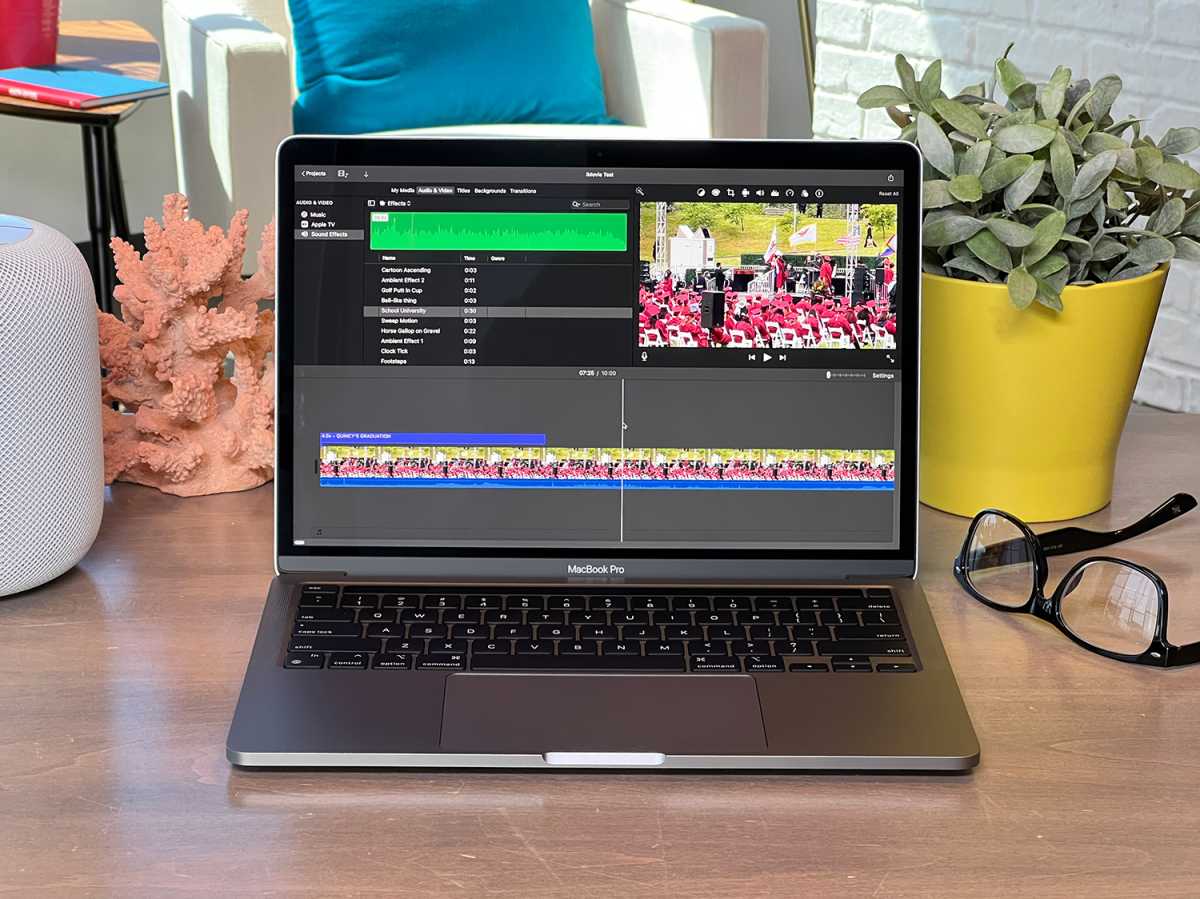 If you need to push your Mac with graphic intensive apps a MacBook Pro would be a better choice
If you need to push your Mac with graphic intensive apps a MacBook Pro would be a better choice
Foundry
CPU
The 2022 MacBook Air and 13in MacBook Pro both run on Apple’s M2 chip. Like the M1 chip, which you can still get in the entry-level MacBook Air, the M2 has eight CPU cores, four of which are high-performance cores and four are high-efficiency cores. This is an advantage of Apple’s chip design: when the high-efficiency processor cores are busy backing up to iCloud or syncing photos the high-performance cores will still be available for more intensive operations. The M2 is superior to the M1 because this time round the faster performance cores are paired with a larger cache, while the efficiency cores see even greater performance gains, according to Apple. So it might look like the CPU is the same, but it isn’t.
In our Geekbench 5 CPU benchmarks we saw that the M2 MacBook Air peak performance was in line with the M2 MacBook Pro, and a bit better than the M1. But it’s not on par with the higher-end M2 Pro and Max processors.
The Cinebench R23 tests show the differences between the M2 MacBook Pro and MacBook Air though – the new MacBook Air was 15 percent faster than the M1 model, but 10 percent slower than the M2 MacBook Pro.
GPU
As you will see from the specs above, another key difference between all the Mac laptops on offer here is the number of graphics cores.
The entry-level MacBook Air doesn’t only offer a less-powerful M1 chip, there are only seven graphics cores compared to the eight or ten graphics cores in the M2 MacBook Air models.
The number of GPU cores might be a key part of the decision about which model is best suited to your needs. If you think you are likely to need that extra GPU core you may think that the best option is to buy the more expensive Air. But the MacBook Pro, which offers a 10-core GPU option, might be a better option, as we will explain.
The reason why the MacBook Pro is a better option for graphic intensive operations than the MacBook Air is that it also includes a fan for cooling – as a result you will be able to push it a little further. The MacBook Air will be perfectly fine for normal operations, but because it lacks a fan you may find that things slow down in order for it not to overheat while you are pushing it.
The Geekbench 5 Compute benchmarks showed scores for the M2 MacBook Air with 10-core GPU were in line with the M2 MacBook Pro and almost 60 percent faster than the old M1 MacBook Air (with 7 GPU cores), and about 40 percent faster than the “full” M1 with 8 GPU cores in the M1 MacBook Pro.
A MacBook Air has never been a great gaming laptop, and even the improvements we find in the M2 don’t change that. But it’s interesting to see how much better it is at running premium games than the M1.
RAM
All the M1 MacBooks – both Pro and Air – come with 8GB of Unified Memory at their base configuration. The M2 chip brings an option to upgrade to 24GB RAM while the M1 is limited to 16GB RAM.
You may be thinking that 8GB RAM won’t be enough for your needs, but you should note that this RAM – which Apple calls Unified Memory – is part of the M2 (or M1) chip. As a result it is accessible to both the CPU and the GPU, which brings performance benefits that means the 8GB RAM in these models isn’t really comparable to 8GB in an Intel-powered Mac.
If you are concerned though you can update your MacBook Air or 13in MacBook Pro to 16GB or 24GB RAM at point of sale – and we do recommend that you get 16GB if you can afford to.
If you feel that you need more than 24GB memory then you will need to turn to the M2 Pro (which ships with 16GB Unified Memory and is upgradable to 32GB), or the M2 Max (which ships also with 16GB Unified Memory, but is upgradable to 64GB or 96GB). It is even possible to get 128GB RAM, but for that you will need the M1 Ultra in the Mac Studio.
Storage
The Air and 13in Pro both come with 256GB of storage at the entry-level, with an additional model offering 512GB. You can also add a larger SSD at point of sale, but the M1 MacBook Air and Pro models are capped at 2TB.
There are some concerns about the 256GB SSD in the entry-level M2 MacBook Air with reports that its SSD is up to 50 percent slower on read speeds and 30 percent on write speeds. We found that these observations were indeed true when we ran our own set of tests using Blackmagic Disk Speed Test.
The 256GB Air showed read speeds that were 47.9 percent slower than the 1TB MacBook Air we also tested. While write speeds were a staggering 50.2 percent slower, far worse than expected. Unfortunately the entry-level Air was also considerably slower than the 2020 model.
MacBook Air vs MacBook Pro: Battery life and charging
When it comes to battery life nothing has changed since the M1 Macs, but these Macs are still miles ahead of the old Intel MacBook models. According to Apple, the M1 and M2 MacBook Air models offer 18 hours, while the 13in MacBook Pro offers an amazing 20 hours. This makes the discontinued 2.0GHz 13in MacBook Pro’s 10 hours battery life look appalling.
In our own testing the MacBook Air battery lasted 17.5 hours, outstripping the M1 MacBook Air and M2 MacBook Pro by almost an hour and a half.
In regular daily use, battery life is just as great. It’s a weird feeling, opening up your laptop and doing work for 20 minutes and seeing that the battery percentage hasn’t changed even a single percent, but that’s how it is with Apple silicon. Obviously battery life varies based on what you’re doing, but for this laptop’s target market–the everyday home and productivity user–it’s hard to think that you’ll ever have to charge up before the day is done.
These number are certainly impressive, although not the most hours of battery life on offer from an Apple MacBook, which is 22 hours for the 2021 16-inch MacBook Pro.
It’s not just battery life that is better on the MacBook Air though. Apple has improved charging speed if you use a good USB-C power adapter. A standard 35W dual-port adapter (which comes with all models of the Air aside from the entry-level model) can achieve a 10 percent charge in 10 minutes (30 percent in 30 minutes). The Apple’s 61W USB-C Power Adapter increases this to 72 percent charge in 30 minutes. See our comparison test of Apple’s new M2 MacBook Air chargers as well as the best USB-C charger for your MacBook.
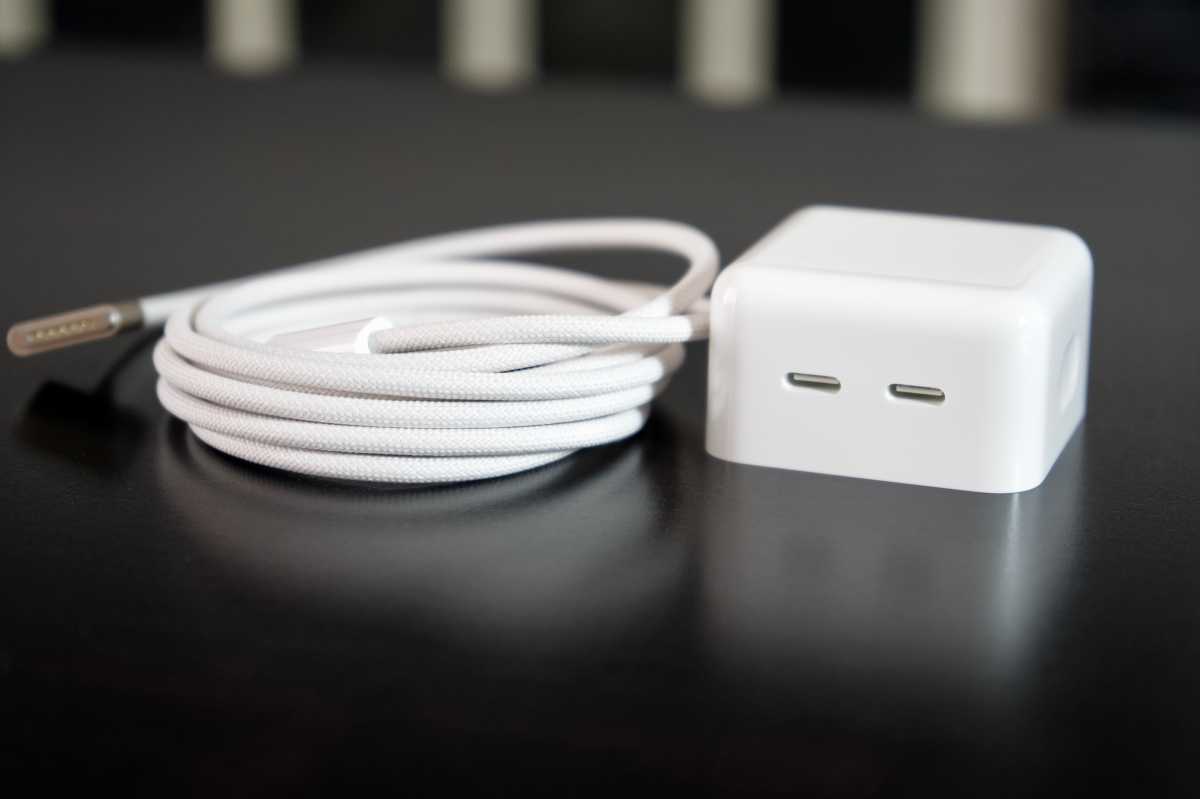 The M2 MacBook Air comes with a nice braided MagSafe cable and compact 35W dual-USB-C Power Adapter (in all but the base configuration).
The M2 MacBook Air comes with a nice braided MagSafe cable and compact 35W dual-USB-C Power Adapter (in all but the base configuration).
IDG
MacBook Air vs MacBook Pro: Ports and expansion
Over the years it’s felt like Apple has been on a mission removing ports from Macs in order to make them slimmer and slimmer. This has been a disadvantage for many, although generally if you need more or different ports you can just plug in an adapter or a dock (read: Best USB-C hubs and adapters for Mac).
With the arrival of the 2022 MacBook Air Apple did add a MagSafe charging port, which means that those two USB ports are still free when you are charging. This puts the 13in MacBook Pro and the older MacBook Air at a disadvantage since they both offer only two USB 4 ports two USB/Thunderbolt ports, so one of those will also be used for charging.
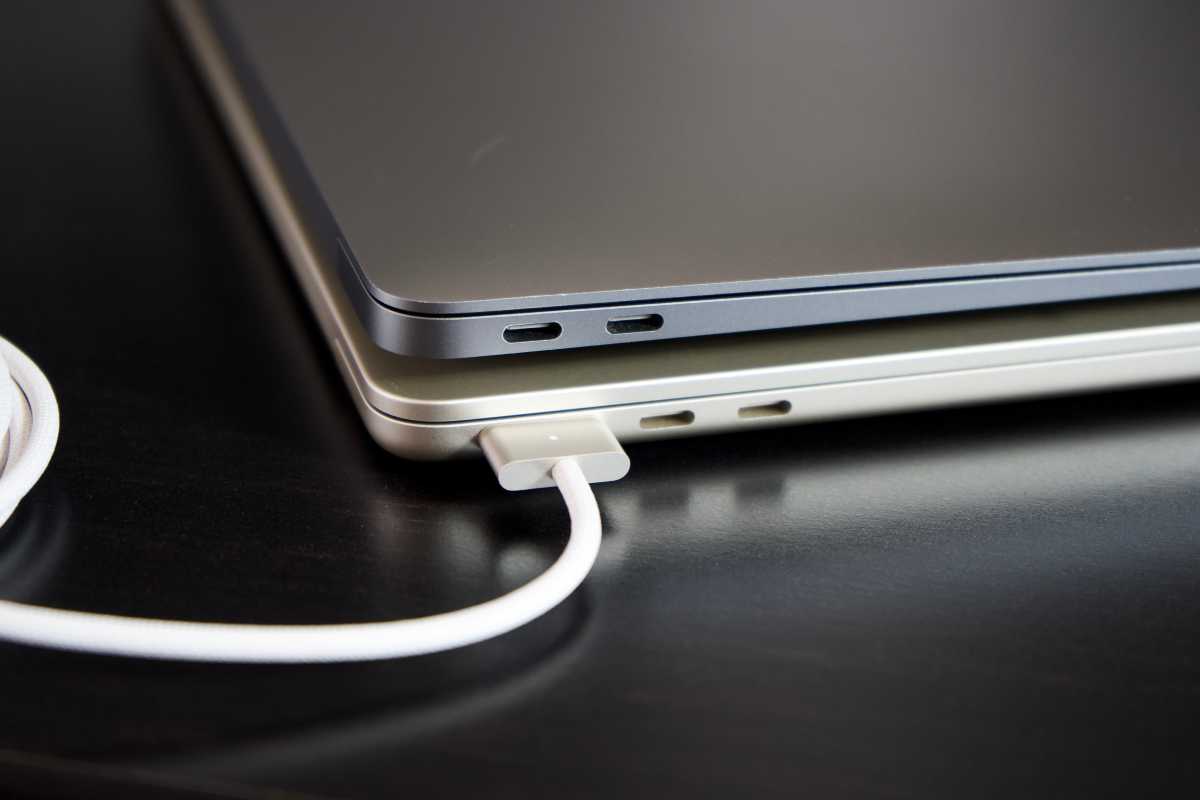 The 2022 MacBook Air has MagSafe as well as two USB/Thunderbolt ports.
The 2022 MacBook Air has MagSafe as well as two USB/Thunderbolt ports.
IDG
If you do feel that you need more ports the 14in MacBook Pro and 16in MacBook Pro have a number of ports available including three Thunderbolt 4 (USB‑C) ports, an HDMI port and a SDXC card slot. (If you are wondering what the difference between USB-C and USB 4 is, USB 4 should be able to offer 40Gb/s, which is what Thunderbolt 3 already offers. USB-C offers 10 to 20Gb/s.)
All Mac laptops offer a 3.5mm headphone jack.
MacBook Air vs MacBook Pro: Price
Regardless of the features, the decision of whether to buy the MacBook Air or MacBook Pro may just come down to price. You might be looking for the cheapest option – in which case the $999/£999 M1 MacBook Air is the clear winner – or you might be happy to pay a little more to get better value for money.
We recommend getting the best machine you can afford at the time of purchase since you won’t be able to upgrade down the line. Normally we’d suggest that you upgrade the RAM before the storage, but given the issues with the storage in the entry-level M2 MacBook Air we’d suggest that you opt for more storage this time round. An M2 MacBook Air with 8-core GPU and 512GB SSD would cost $200/£200 more at $1,399/£1,449 but at that point you might as well spend another $100/£100 on the 10-GPU core model.
We’ll run through the pricing for the different models below, including some of the latest offers on new MacBooks – because you don’t necessarily have to pay Apple’s price. We also recommend checking the Apple Refurbished Store to see if you could pick up a discounted MacBook.
MacBook Air prices
The
MacBook Air is available in two default configurations:
- M1 Chip with 8‑Core CPU and 7‑Core GPU, 8GB RAM, 256GB SSD: $999/£999.
- M2 Chip with 8‑Core CPU and 8‑Core GPU, 8GB RAM, 256GB SSD: $1,199/£1,249.
- M2 Chip with 8‑Core CPU and 10‑Core GPU, 8GB RAM, 512GB SSD: $1,499/£1,549.
Buy directly from Apple, or look below for the best prices right now:
M2 MacBook Air, 8-core GPU (MSRP: $1,199/£1,249)
When the M2 MacBook Air goes on sale you will see prices below.
M2 MacBook Air, 10-core GPU (MSRP: $1,499/£1,549)
M1 MacBook Air, 7-core GPU (MSRP: $999/£999)
For deals on even more MacBook Air check out our best MacBook Air deals article for discounts available elsewhere.
13in MacBook Pro prices
There are two 13in configurations of the MacBook Pro sold by Apple:
- M2 Chip with 8‑Core CPU and 8‑Core GPU, 16GB RAM, 256GB SSD: $1,299/£1,349
- M2 Chip with 8‑Core CPU and 10‑Core GPU, 16GB RAM, 512GB SSD: $1,499/£1,549
You’ll notice that the more expensive Air is the same price as the more expensive 13in MacBook Pro. Both share the same specs. The difference is in the design.
Buy directly from Apple, or look below for the best prices right now:
M2 MacBook Pro, 10-core GPU, 256GB SSD (MSRP: $1,299/£1,349)
When the M2 MacBook Pro goes on sale you will see prices below.
M2 MacBook Pro, 10-core GPU, 512GB SSD (MSRP: $1,499/£1,549):
When the M2 MacBook Pro goes on sale you will see prices below.
We also recommend that you take a look at our round up of the best MacBook Pro deals right now.
MacBook Air vs MacBook Pro: Buying advice
The MacBook Air and 13in MacBook Pro are both great MacBooks. Really the decision has to be based on your budget. If a low price is the most important to you then the M1 MacBook Air is the best option, but you just need to weigh up whether getting twice as much storage is more valuable to you than the MacBook Pro’s better battery life, extra graphics core and fan. If you don’t do the kind of work that requires lots of graphics processing the 7-core MacBook Air could be sufficient.
If it’s a choice between the M2 MacBook Air and M2 MacBook Pro, the new design and better screen of the M2 MacBook Air do edge it ahead a little. The M2 MacBook Pro has little going for it other than the Touch Bar and the fact that it has better cooling than the MacBook Air, so if you need to use your Mac for intensive work the Pro might be better for you.
But if you really need the ultimate in power then you really should be looking at the 14in MacBook Pro and the 16in MacBook Pro, which offer more graphics cores and support more RAM. They also offer a bunch of ports that will benefit many.
Decided to get a MacBook, Pro or Air? Check out the best accessories for MacBooks.
Still not sure? We also look at how the MacBook Air compares to the iMac and how the MacBook Air and Mac mini compare separately. We also help you choose the Best Mac in our buying guide.






